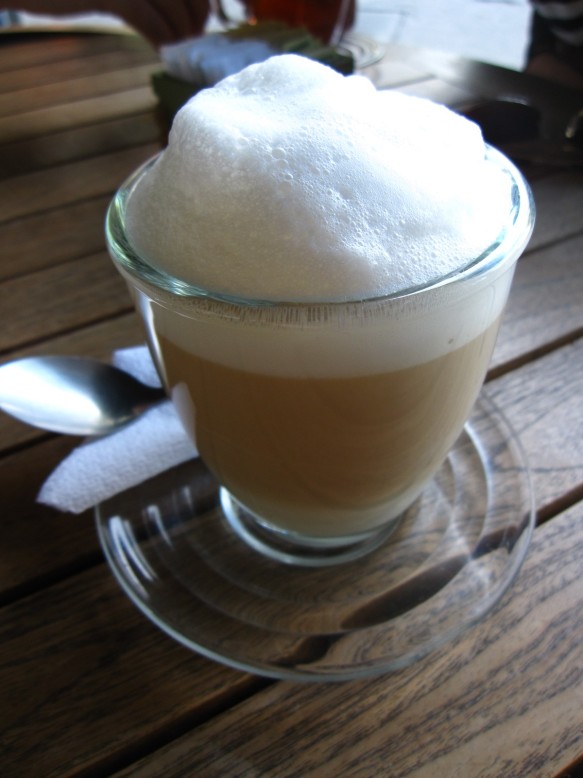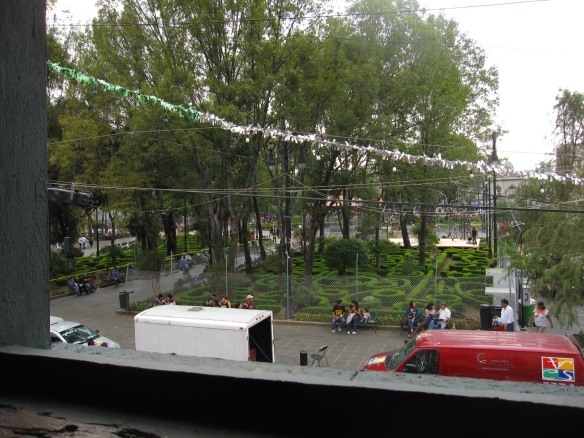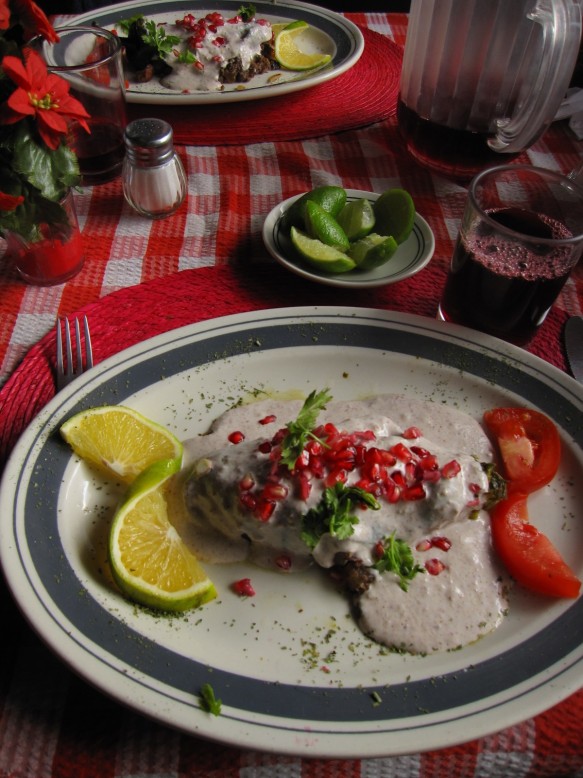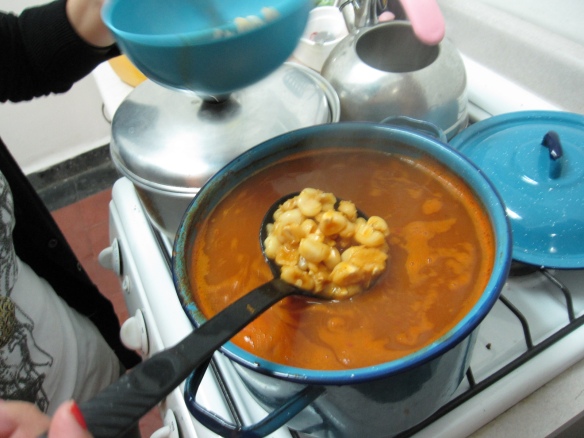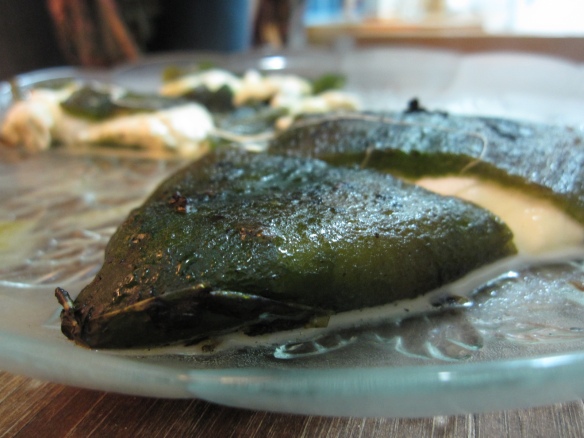 Dare I say it, but it’s almost like fall is really here. The mornings have been gray and chilly, clearing up for crisp sunny late afternoons. My first fall in California I waited and waited for the seasons to change. I did everything possible to evoke the autumn, but finally my mom had to send me a box of colorful fall leaves for me to feel content, or maybe just pacified, as I don’t think I’ve registered a new season once since coming here. Now I barely notice, except a couple times this summer when I smelled freshly mowed grass and really felt it was summer. Any hint of cold now, and I just assume it’s fall. And with fall comes soup. I’d been thinking of corn chowder for a while, but never looked up a recipe. The result was creamy, but in a vegetable kind of way, and some wonderful mixture of summery corn and wintry potato soup. As with all soups I make, they tend to just contain every vegetable in my kitchen, except this time I used some self-restraint: no tomatoes, garlic, or red peppers, although I think it could have been good with all three.
Dare I say it, but it’s almost like fall is really here. The mornings have been gray and chilly, clearing up for crisp sunny late afternoons. My first fall in California I waited and waited for the seasons to change. I did everything possible to evoke the autumn, but finally my mom had to send me a box of colorful fall leaves for me to feel content, or maybe just pacified, as I don’t think I’ve registered a new season once since coming here. Now I barely notice, except a couple times this summer when I smelled freshly mowed grass and really felt it was summer. Any hint of cold now, and I just assume it’s fall. And with fall comes soup. I’d been thinking of corn chowder for a while, but never looked up a recipe. The result was creamy, but in a vegetable kind of way, and some wonderful mixture of summery corn and wintry potato soup. As with all soups I make, they tend to just contain every vegetable in my kitchen, except this time I used some self-restraint: no tomatoes, garlic, or red peppers, although I think it could have been good with all three.
 Fresh Corn Soup
Fresh Corn Soup
1 medium candy onion, diced
3-4 medium potatoes, diced into 1/4-inch cubes
3 small stalks celery, diced
1 large carrot, peeled and diced
3 ears-worth of fresh corn kernels
2 bay leaves
Dash of cayenne pepper, or to taste,
Salt and pepper
Olive oil and 1/2 tablespoon butter
In the soup pot, heat oil and butter and add onions, cooking until the onions are tender. Add the diced veggies (everything but the corn) and stir to coat with the oil and butter. Add enough water, or chicken broth if you prefer, to the pot to cover the veggies by an inch or more. I often add more water if necessary later on, and never measure (sorry!). Add freshly ground pepper, salt, bay leaves, and the dash of cayenne. Let the soup simmer for 20 minutes or so. Add the corn kernels and cook for another 20 minutes, or until the soup broth tastes “done”, which I realize is a very imprecise term. I find that there is a transition in soup broths that happens after a certain amount of cooking: before the transition the soup broth is watery, and afterwards it is infused with flavor.
 I was so pleasantly surprised by how this soup was exactly what I wanted, that I had to eat a mug of it for dinner, even though there were toasts in the oven. (And yes, mugs are most excellent soup containers, and are beautifully featured in Vegetable Soups from Deborah Madison’s Kitchen. I’m quite jealous of the ceramic mugs especially.) Perhaps I should better explain what I mean by toasts: delicious things on toasted bread, my favorites being cheese, onion, basil, tomato, garlic, leafy greens, and roasted vegetables. These get a bold recipe title even though an ingredient list is kind of absurd, since pretty much every ingredient could be served on bread.
I was so pleasantly surprised by how this soup was exactly what I wanted, that I had to eat a mug of it for dinner, even though there were toasts in the oven. (And yes, mugs are most excellent soup containers, and are beautifully featured in Vegetable Soups from Deborah Madison’s Kitchen. I’m quite jealous of the ceramic mugs especially.) Perhaps I should better explain what I mean by toasts: delicious things on toasted bread, my favorites being cheese, onion, basil, tomato, garlic, leafy greens, and roasted vegetables. These get a bold recipe title even though an ingredient list is kind of absurd, since pretty much every ingredient could be served on bread.
Toasts with Cheese, Shallots, Basil, and Tomatoes
(all amounts depend on the number of toasts to be made and the hunger of the cook)
Slices of good bread (sandwich bread not ideal here, go for something with a legitimate crust)
Thin slices of melty cheese, such as cheddar, jack, gruyere, or mozarella
Fresh basil leaves
Thin slices of young shallots (not the dried-skinned variety) or slices of green onion or sweet red onion
Thick slices of juicy, flavorful tomatoes
Preheat the oven to 350 degrees F. Put the bread slices on a baking sheet with the slices of shallots or onion on top. Bake them for 10 minutes or so for the onion to lose its punch. Top the toasts with cheese and bake again just until the cheese is melty and browned a bit, another 10 minutes? Top the finished toasts with basil leaves and tomato. I like rubbing the tomato slices into the bottom of the toast to make it slightly soggy, don’t ask me why. I alternate whether the bread is toasted with the tomatoes on top or not, but when the tomatoes are truly fabulous they probably deserve to be eaten raw.

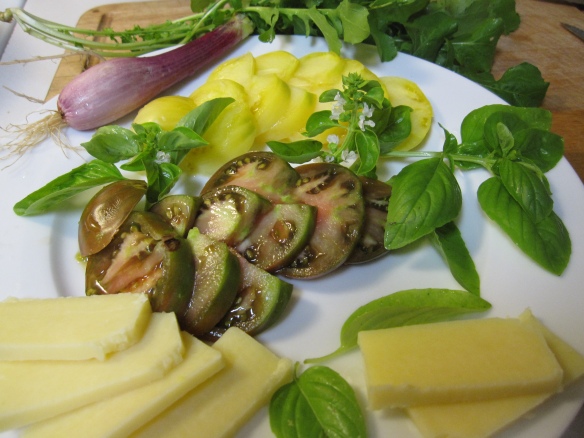
 Let’s just pretend this is actually a travel blog for just a moment. The Mexican pyramids at Teotihuacan are the only ones I’ve ever seen, but even on my second visit there, with Peter in addition to Meredith this time, they were astounding. We walked to the top of the larger pyramid, the pyramid of the Sun, but only part of the way up the pyramid of the Moon because higher levels were closed. Walking up the pyramids is the easy part, because coming down there aren’t many handrails, and the steps are steep. I wanted to join the small children going down by sitting on each step, one at a time. Peter also pointed out that you could just slide down the side of the pyramid on a plastic bag, at which point I was happy I had him distracted helping me not freak out on the descent.
Let’s just pretend this is actually a travel blog for just a moment. The Mexican pyramids at Teotihuacan are the only ones I’ve ever seen, but even on my second visit there, with Peter in addition to Meredith this time, they were astounding. We walked to the top of the larger pyramid, the pyramid of the Sun, but only part of the way up the pyramid of the Moon because higher levels were closed. Walking up the pyramids is the easy part, because coming down there aren’t many handrails, and the steps are steep. I wanted to join the small children going down by sitting on each step, one at a time. Peter also pointed out that you could just slide down the side of the pyramid on a plastic bag, at which point I was happy I had him distracted helping me not freak out on the descent.

 One of our other favorite places in Mexico was Chapultepec, a large park only a short bus ride away. This park has really got it going on: it has a castle, a lake (the color of green goo), a rockin’ anthropology museum that we didn’t have time to visit, and a free zoo! I think we (I) took more pictures of cute animals than anything.
One of our other favorite places in Mexico was Chapultepec, a large park only a short bus ride away. This park has really got it going on: it has a castle, a lake (the color of green goo), a rockin’ anthropology museum that we didn’t have time to visit, and a free zoo! I think we (I) took more pictures of cute animals than anything.



 And now, the winner for most strung out:
And now, the winner for most strung out: If only one of them had been swimming, or perhaps doing a graceful ballet number as per Fantasia.
If only one of them had been swimming, or perhaps doing a graceful ballet number as per Fantasia.





